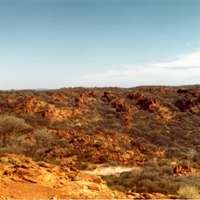Solution to ancient rock puzzle posited

A superplume, or massive episode of volcanic eruptions that related to extensive melting of the Earth's mantle, could explain the puzzling reappearance of major iron formations long after the rise in atmospheric oxygen about 2.4 billion years ago, which should have prevented iron forming, according to a study published in Nature this week.
The research team, led by Professor Birger Rasmussen of Curtin University, includes Dr Janet Muhling from The University of Western Australia's Centre for Microscopy, Characterisation and Analysis.
Iron formations are unique sedimentary rocks composed of iron and silica and are unlike any modern rocks, the study noted. Most iron formations were deposited in the oceans before free oxygen first accumulated in Earth's atmosphere about 2.4 billion years ago (the so-called Great Oxidation Event).
However, the re-occurrence of major iron formations nearly 500 million years later has been an enduring enigma for geologists.
Major iron formations about 1.9-1.8 billion years old occur in both North America and Australia. However, because the Australian iron formations were thought to be significantly younger than those in North America, it was uncertain whether they provided information about the composition of the global ocean or conditions in a restricted or closed basin.
The new study has dated volcanic ash beds in the Australian iron formations, showing that they were deposited at the same time as those in North America.
"These results show that the deposition of iron formations from two different continents was synchronous 1.9 billion years ago and therefore probably reflects the composition of the global ocean," the study said. "The deposition of major iron formations shows a remarkable correlation in time with a short-lived but intense interval of global igneous activity, a possible mantle superplume event, which suggests that processes deep within the Earth radically changed the chemistry of the global ocean."
"We suggest that extensive basaltic magmatism related to the superplume released vast volumes of iron into the global ocean, overwhelming the supply of oxygen and promoting the deposition of iron formations across the world," Dr Muhling said.
"The equally dramatic disappearance of iron formations some 40 million years later can be explained as a consequence of rapidly waning igneous (volcanic) activity that allowed the ocean to become dominated by seawater oxidants once more.
"Our findings not only explain the sudden appearance and disappearance of iron formations circa 1.9 billion years ago, but also provide an explanation for the preservation of an oxygen-rich atmosphere above an oxygen-poor ocean. The relationships between the chemistry of the hydrosphere and atmosphere, and deep Earth processes provide insights into significant events in the evolution of the Earth," Dr Muhling said.
Dr Muhling's co-researchers are from Curtin University, the WA Department of Mines and Petroleum's Geological Survey of WA, and the University of Manitoba in Canada.
Provided by University of Western Australia



















